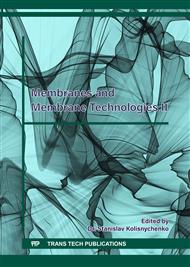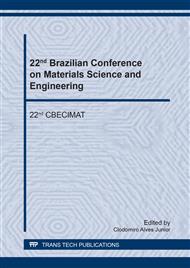p.241
p.248
p.254
p.258
p.264
p.270
p.276
p.283
p.293
PA6/Sodium Clay Membrane for Application in Petroleum Sector
Abstract:
Membrane is a barrier that separates two phases and limits, totally or partially, the transportation of one or various chemical species present in the phases. In this study, were obtained membranes of polyamide6 (PA6)/sodium clay from the technique immersion-precipitation. Membranes were characterized by diffraction of X-ray (XRD), differential scanning calorimetry (DSC), scanning electron microscopy (SEM) and the permeation of water vapor. For DRX, verified the disappearance of the clay characteristic peak, indicating obtaining an exfoliated and/or partially exfoliated structure. Analysis by DSC indicated that the presence of the clay leading to an increase in the crystallinity of the membranes. SEM photomicrographs showed that the presence of clay caused changes in membrane morphology and pore formation. In the water vapor permeation, the presence of clay promoted an increase in the permeability of membranes to be compared with the pure PA6 membrane. Thus, these membranes have potential for the treatment of effluents from industry of oil.
Info:
Periodical:
Pages:
264-269
Citation:
Online since:
September 2018
Keywords:
Price:
Сopyright:
© 2018 Trans Tech Publications Ltd. All Rights Reserved
Share:
Citation:



